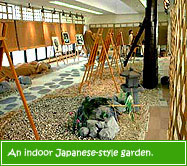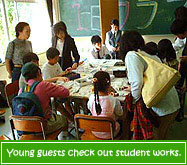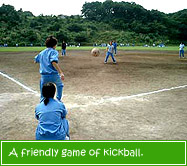 The theme of the 1999 Camphor Festival, named after the large tree growing on the school grounds, was "The Egg"--breaking out of your shell and evolving. The athletic meet, which was held on the school's spacious grounds, featured basketball, volleyball, and even kickball. |
Kanagawa
University High School
|
|
|
|
||
|
1 School Festival
|
||
 The
festival has a different theme each year. The theme of the 1999 festival,
held on October 9 and 10, was "The Egg"--the concept of breaking
out of your shell and growing or evolving. Each class does a different
project based on the theme. In a visitors' ballot on which presentations
they liked the best, the class that came in first was eighth grade class
F. Students cultivated kenaf, a plant that is attracting attention as
an alternative to tree-based papers, keeping a diary of its growth and
putting together a report on the state of paper recycling today. They
also handed out kenaf seeds to visitors and appealed for the conservation
of resources. At various places in the schoolyard, kenaf plants were growing
tall, prompting one of the project's leaders to claim, "I'm ecstatic
about the prize. It's great to know that our efforts to raise the plants
for the Camphor Festival, which began even before summer vacation, was
rated so highly." The
festival has a different theme each year. The theme of the 1999 festival,
held on October 9 and 10, was "The Egg"--the concept of breaking
out of your shell and growing or evolving. Each class does a different
project based on the theme. In a visitors' ballot on which presentations
they liked the best, the class that came in first was eighth grade class
F. Students cultivated kenaf, a plant that is attracting attention as
an alternative to tree-based papers, keeping a diary of its growth and
putting together a report on the state of paper recycling today. They
also handed out kenaf seeds to visitors and appealed for the conservation
of resources. At various places in the schoolyard, kenaf plants were growing
tall, prompting one of the project's leaders to claim, "I'm ecstatic
about the prize. It's great to know that our efforts to raise the plants
for the Camphor Festival, which began even before summer vacation, was
rated so highly."
|
||
|
2 Athletic Meet
|
||
 The
meet is run by an operating committee composed of two students from each
class, who are elected by their classmates to serve as representatives.
The operating committee takes care of everything needed to make the games
run smoothly. For example, it puts together the roster of competitors
and makes out the schedule of events. Committee members usually begin
organizing the meet before the start of summer vacation. The
meet is run by an operating committee composed of two students from each
class, who are elected by their classmates to serve as representatives.
The operating committee takes care of everything needed to make the games
run smoothly. For example, it puts together the roster of competitors
and makes out the schedule of events. Committee members usually begin
organizing the meet before the start of summer vacation.
|
||
 The
students experience the fun of sports and athletic competition on a daily
basis in their gym classes and club activities. But the schoolwide athletic
meet makes everyone feel especially competitive. It's a way of showing
each class's cooperative spirit. The
students experience the fun of sports and athletic competition on a daily
basis in their gym classes and club activities. But the schoolwide athletic
meet makes everyone feel especially competitive. It's a way of showing
each class's cooperative spirit. |
||
| Even
as the kids rushed to finish their box lunches, they continued to root
for their classes. "As long as we're competing, I don't want to lose,"
claimed one student. "We spend a lot of time together because we're
in the same class, but events like this really give us a chance to work
together as a team."
For the meet itself, the students dress up in their team colors, heightening the drama of athletic competition. It's a fun-filled day, with all students working up a sweat and growing hoarse from cheering. The action continues without interruption from 9:00 in the morning until 3:00 in the afternoon, when the closing ceremony is held.
|
||
|
|
||

 The
camphor tree you see straight ahead of you as you enter the school's
main gate not only provides shade and enhances the beauty of the schoolyard;
it's also the school symbol. The school festival, which takes place
every autumn, is thus called the Camphor Tree Festival.
The
camphor tree you see straight ahead of you as you enter the school's
main gate not only provides shade and enhances the beauty of the schoolyard;
it's also the school symbol. The school festival, which takes place
every autumn, is thus called the Camphor Tree Festival. The
middle school student council, meanwhile, worked with the
The
middle school student council, meanwhile, worked with the  The
annual schoolwide athletic meet was held on September 25 under a blue
sky in 1999. A trace of summer heat lingered in the air. Voices of students
in sportswear were heard yelling "Ganbare!" (Keep it up!)
to cheer on their classmates. "We beat class C in volleyball,"
elated another group. At Kanagawa University High School, classes compete
against each other in a variety of events, including basketball, volleyball,
softball, soccer, kickball, tug-of-war, and kibasen, a game in which
teams of "riders" standing on "horses" of three
people try to make other teams' riders fall. The students participate
in the contest they're best at, but some events call for all class members
to take part.
The
annual schoolwide athletic meet was held on September 25 under a blue
sky in 1999. A trace of summer heat lingered in the air. Voices of students
in sportswear were heard yelling "Ganbare!" (Keep it up!)
to cheer on their classmates. "We beat class C in volleyball,"
elated another group. At Kanagawa University High School, classes compete
against each other in a variety of events, including basketball, volleyball,
softball, soccer, kickball, tug-of-war, and kibasen, a game in which
teams of "riders" standing on "horses" of three
people try to make other teams' riders fall. The students participate
in the contest they're best at, but some events call for all class members
to take part.